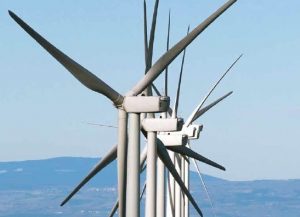Statoil’s innovative new offshore floating Hywind wind turbine, now successfully moored in the North Sea off the Norwegian coast, is demonstrating how Trelleborg Offshore’s syntactic foam buoyancy technology is contributing to the future of offshore power generation. “It is subsea technology that has already been extensively proven,” says Gary Howland, renewables sales manager for Trelleborg Offshore. “Trelleborg Distributed Buoyancy Modules (DBMs) developed for deepwater support of umbilicals and risers in the oil and gas industry are ideal for this application, helping reduce project risk by using proven technology.
“People see the tower and turbine but forget that the expertise in designing the subsea portion is also critical,” he says, “as ultimately it keeps the whole turbine afloat. The dynamic floating structure weighs 5,300 tons and is 165 metres tall; with a total of 65 metres above sea surface. The 13km of power offtake and communications cabling attached to the structure further adds to its weight. It’s like the proverbial iceberg; the mass floating below the surface ensures stability. Unless the weight is supported by properly designed buoyancy the whole structure would be much less able to resist the extremes of the offshore environment and the cable could suffer premature damage.”
For Hywind, Trelleborg Offshore designed and supplied 45 off polymer-coated syntactic foam DBMs which supply buoyancy support for a 3 ton, 100 meter section of cable as it exits the turbine spar and descends to the sea bed at -220 meters. The buoyancy modules include an internal clamp for secure fastening and precise positioning on the cable. The cable is supported mid-water in what is known as a ‘Lazy Wave’ configuration, featuring gentle long radius curves that minimise stress on the cable while accommodating natural movement created by wind and waves.
“For optimum buoyancy under different sea conditions, the precise position of the buoyancy modules on the cable is pre-calculated,” Howland explains. “The positions must be maintained, despite stresses during launch and in operation. The clamp is crucial; the design, material selection and manufacturing technique are critical in ensuring the finished clamp maintains the buoyancy module position, during cable contraction and expansion, over the 20 year lifetime of the project.”
Using advanced polymer material technology, Trelleborg Offshore provides high integrity solutions for the harshest and most demanding offshore environments. As part of the Trelleborg Engineered Systems Business Area of Trelleborg Group, it specializes in the development and production of polymer and syntactic foam based seismic, marine, buoyancy, cable protection, and thermal insulation products, as well as rubber-based passive and active fire protection solutions for the offshore industry. Go online to www.trelleborg.com/offshore.

























